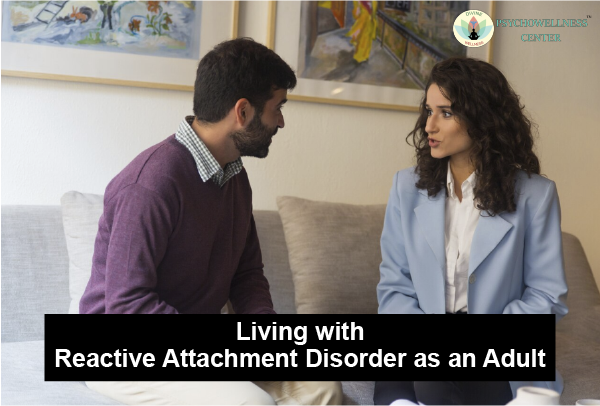Reactive Attachment Disorder (RAD) is often associated with children, especially those who have experienced severe neglect, abuse, or multiple foster placements. But RAD doesn’t always disappear with age—it can linger into adulthood, quietly influencing the way we connect, cope, and care for others and ourselves. Living with RAD as an adult can feel like navigating relationships through a fog—everything is unclear, connection feels unsafe, and trust is a foreign language.
What is Reactive Attachment Disorder?
RAD is a rare but serious condition that arises when a child doesn’t establish healthy attachments with primary caregivers during the critical developmental years, usually before age five. In adulthood, this disrupted attachment style doesn’t simply vanish—it mutates. It can manifest as emotional distance, chronic distrust, fear of intimacy, a deep-seated belief that people will inevitably disappoint or abandon you, or an inability to regulate emotions in relationships.
For many adults, RAD isn’t officially diagnosed—most clinicians focus on disorders like Borderline Personality Disorder (BPD), PTSD, or complex trauma. But for those who trace their pain back to early relational wounds and feel perpetually out of sync in emotional closeness, RAD may be a root cause.
How RAD Shows Up in Adult Life
- Struggles with Intimacy:- Individuals with Reactive Attachment Disorder (RAD) may desire intimacy, yet also experience a profound fear of it. Intimate relationships can trigger intense anxiety. As soon as someone gets too close, the instinct to push them away kicks in—either emotionally withdrawing or sabotaging the relationship. It’s not about being cold-hearted; it’s self-preservation.
- Extreme Independence:- RAD adults often pride themselves on fierce independence. But this “I don’t need anyone” mindset can be a defence against the vulnerability of depending on others.
- Emotional Numbness or Overreaction:- Some adults with RAD have difficulty feeling or expressing emotions, while others feel emotions so intensely that they become overwhelming. It’s often an all-or-nothing experience—either shut down or erupting.
- Persistent Mistrust:- Trust doesn’t come easily. Even when people are consistently kind or reliable, those with RAD may question their motives, bracing themselves for the moment they will be hurt or betrayed.
- Low Self-Worth:- Deep down, many RAD-affected adults carry the belief that they are unlovable or undeserving of care. This belief shapes their relationships, leading them to either accept poor treatment or avoid connection altogether.
The Internal Experience
Imagine living with a constant sense that people aren’t safe, that love is conditional, and that abandonment is always around the corner. Even in moments of joy, there’s a shadow—the lingering fear that it won’t last or isn’t real.
This inner world often involves:
- Heightened awareness in relationships (interpreting every word or gesture)
- Chronic loneliness despite being surrounded by people
- Difficulty trusting even your own emotions
- Feeling “different” or disconnected from others
- Wanting love but pushing it away the moment it arrives
Coping Strategies (That Sometimes Backfire)
Adults with RAD often develop coping mechanisms that make sense in the short term but may hurt them in the long run:
- Avoiding relationships to feel safe
- Using work or achievement to gain self-worth
- People-pleasing to avoid abandonment
- Isolating when feeling overwhelmed
- Testing partners to prove their loyalty
These strategies are survival-based, often developed in childhood, but they can keep adults trapped in cycles of fear and disconnection.
Healing Is Possible—But It’s a Journey
Healing from RAD as an adult is possible, but it requires intentional work, compassion, and safe relationships. Here are several approaches to embark on that journey:
- Trauma-Informed Therapy:- Working with a therapist trained in attachment issues, trauma, or somatic therapies can be life-changing. Therapies like EMDR (Eye Movement Desensitisation and Reprocessing), Family Systemic Therapy, ACT, DBT and trauma-focused CBT can help reprocess early wounds and build emotional resilience.
- Practising Safe Attachment:- Creating even one safe, trusting relationship can be transformational. Whether with a partner, friend, or therapist, experiencing a consistent, healthy connection helps rewire the nervous system.
- Learning Emotional Regulation:- Mindfulness, journaling, breathwork, and grounding exercises can help you become more aware of your emotional triggers and regulate your reactions, rather than acting from fear or reactivity.
- Challenging Old Beliefs:- Many adults with RAD carry internalised beliefs from childhood: “I’m unlovable,” “People always leave,” or “I can’t trust anyone.” Naming and challenging these thoughts is crucial. You may start by questioning yourself: “Is this belief accurate?” Where did I learn this? Is there evidence to the contrary?”
- Building a Support System:- Even if trust feels impossible, small steps toward building connection matter. This might mean joining a support group, engaging in a hobby with others, or simply allowing someone to help you with a task.
What Loved Ones Should Know
Their reactions aren’t about you—they’re survival instincts rooted in early trauma. Here’s how you can support them:
- Be consistent. Reliability builds trust.
- Respect their need for space, but gently offer connection.
- Avoid taking emotional withdrawal or defensiveness personally.
- Encourage them to seek therapy, but don’t try to “fix” them yourself.
Loving someone with RAD takes patience and understanding, but know that their struggles aren’t a lack of love. Often, they love deeply but are terrified of losing control or being hurt.
Contributed by Ms Srishti Jain, Counselling Psychologist.
References
- Courtois, C. A., & Ford, J. D. (2016). Treatment of complex trauma: A sequenced, relationship-based approach. Guilford Publications.
- Heller, L., & LaPierre, A. (2012). Healing developmental trauma: How early trauma affects self-regulation, self-image, and the capacity for relationship. North Atlantic Books.
- Lyons-Ruth, K. (2006). Contributions of the mother–infant relationship to dissociative, borderline, and conduct symptoms in young adulthood. Infant Mental Health Journal, 27(3), 203–219.
- Schore, A. N. (2003). Affect dysregulation and disorders of the self. W. W. Norton & Company.

